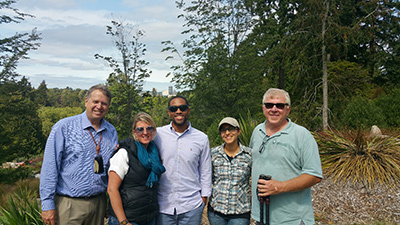
In August, the NRPA conservation team took a trip to the rainy city to meet with staff from Seattle Parks and Recreation, and tour several of the city’s most iconic parks. The agency is responsible for the management of over 6,200 acres, including 450 parks, 185 athletic fields, and an impressive assemblage of playgrounds, community centers, viewpoints, fishing piers and boat ramps. They are also responsible for managing a diverse collection of major attractions such as the Volunteer Park Conservatory, the Washington Park Arboretum, the Seattle Aquarium and the Woodland Park Zoo.

Seattle Parks and Recreation has been nationally recognized for their excellence in a variety of areas, including professional and voluntary service, programming, research and public outreach. The goal of our trip was to identify the key elements that make Seattle Parks and Recreation so successful.
Seattle is a city that loves to give back to its public green spaces. It’s well known that the city’s parks are well maintained and receive an immense amount of community support. With mesmerizing views of Mt. Rainer, close proximity to Olympic National Park and towering evergreens, it’s easy to see why Seattleites feel compelled to protect their urban green spaces. But we wanted to dig a little deeper, so we met with Seattle’s Urban Forestry Manager, Jon Jainga, to get an overview of their game-changing conservation programs.
In 2004, Seattle’s parklands faced a critical threat. Experts projected that without serious intervention, Seattle parks would lose 70 percent of their trees by 2042. In response, Seattle Parks and Recreation launched the Green Seattle Partnership (GSP), the largest urban forest restoration program in the nation. It is a collaborative effort between the City of Seattle, the Forterra Land Conservancy and thousands of community partners. The goal of the program is to use a locally-recruited volunteer workforce to restore all 2,500 acres of Seattle’s degraded urban parklands.
The program has been wildly successful. To date, volunteers have logged over 781,000 volunteer hours, valued at an astounding $18 million, while revitalizing thousands of urban parks and communities. The program has galvanized an informed, involved and active community around forest restoration and stewardship, while simultaneously establishing resources to provide long-term maintenance and ensure the sustainability of forested parklands.
Another impressive, volunteer-driven program we learned about is the P-Patch Community Garden program. The program manages and promotes community-stewarded open spaces for organic urban agriculture to individuals and groups. In 2012, gardeners contributed over 32,690 volunteer hours and donated nearly 50,000 lbs. of fresh produce to area food banks and feeding programs. To see the program in action we visited the Beacon Food Forest, believed to be the largest food forest on public land in the United States. The site is adjacent to Jefferson Park and while the parks department offers their support to the project, the project is wholly a grassroots run initiative.
A key element to the success of Seattle’s programs is the ability to effectively recruit, empower and retain local volunteers. Volunteers in Seattle are clearly highly motivated, but that alone is not enough to have a successful volunteer workforce. What was apparent to us is that Seattle Parks and Recreation has developed a system to support volunteerism, to empower volunteers and to give them a sense of ownership. Promoting volunteer events as social gatherings, where neighbors can meet and new friendships can be made, increases volunteerism and cohesion in communities. By providing high-value educational resources and in-depth training, volunteers feel empowered to make lasting impacts in their communities. By giving volunteers the autonomy to make important decisions, they feel a genuine sense of ownership over projects.
Though it can add delays, Seattle is a city that values public engagement and believes in investing in its volunteers. Volunteering is an avenue for people to learn more about Seattle, connect to fellow residents and leave things a bit better than they were.
Roland Richardson is NRPA’s Development Officer of Conservation.

